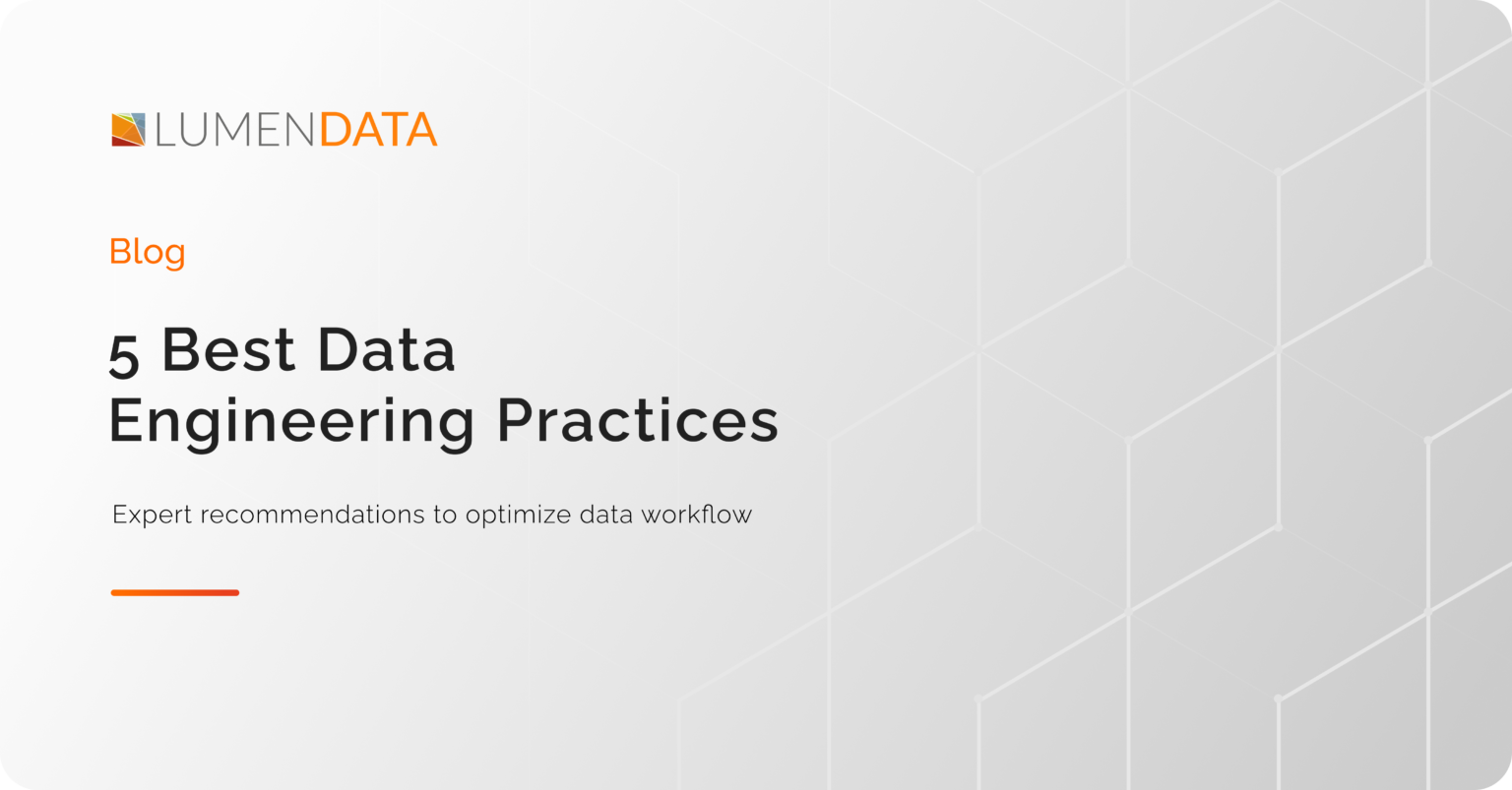Approximately 328.77 million terabytes of data are generated each day. Every single click on the internet, every transaction, or every online interaction creates a vast sea of data that has the power to transform businesses, but only if nurtured correctly. This is where the evolving concept of data engineering steps in, ensuring that the raw data is converted into actionable insights. Yet, amid the buzz, a significant knowledge gap about data engineering persists. Many organizations remain uncertain about the best practices that can truly optimize data workflows. The blog piece will explore key principles and techniques that can ensure improved operational efficiency for organizations.
But before we dive into those practices, let us quickly understand the significance of data engineering and the pivotal role data engineers play in building a robust data infrastructure framework for your business.
The importance of data engineering and data engineers
Data engineering is a critical discipline within the field of data management and analytics. It involves designing, constructing, maintaining, and optimizing systems and infrastructure to effectively collect, store, and process data. It is the foundation of the entire data lifecycle and lays out the structured roadmap for data to flow efficiently. Some of the key aspects of data engineering include data ingestion, data transformation, data pipeline orchestration, data governance, and more.
At the heart of the dynamic field of data engineering are data engineers who navigate the complexities of data infrastructure and convert data into useful knowledge.
As Gartner puts it, “Data engineers play a key role in building and managing data pipelines, and promoting data and analytics use cases to production in line with business processes.”
Data engineers play a crucial role in establishing that data is accurate, accessible, and in the right format for data analysts, data scientists, and other stakeholders to support more informed decision-making within the organization.
Let’s understand this with the help of a simple analogy. Think of data engineers as the architects and builders of a well-structured library. Just as the architects design the library’s layout and ensure it’s organized for easy access – data engineers design and develop the data infrastructure. They decide how data is stored and make sure it’s organized for analysis. Also, they construct data pipelines and storage systems to house sensitive information and ensure it’s available when needed.
Best data engineering practices
Adhering to modern data engineering practices ensures that the data is of high quality and that organizations can function securely and compliantly. Businesses that excel in data engineering gain a competitive edge as they can respond more swiftly to market changes and deliver better products/services based on actionable insights. Let’s look at some of the most significant data engineering practices that businesses should implement:
1. Building scalable data pipelines
Developing scalable data pipelines is a fundamental practice in data engineering. Data processing workflows are constructed with a view to handling increasing data volumes and growing market demands without sacrificing data reliability. Scalable pipelines can seamlessly process larger datasets without requiring major architectural overhauls.
Research says that data engineers invest 80% of their time in data pipeline designing, developing, and resolving issues. The best aspect of building scalable data pipelines is automation. Data processing tasks are automated, reducing manual intervention, and freeing up data engineers to focus on more strategic data operations. Informatica’s cloud-native, scalable data engineering solutions enable you to build intelligent, automated data pipelines in the cloud for AI and advanced analytics. Informatica and Databricks have partnered to accelerate data engineering pipelines with a no-code, visual development environment. It helps gain complete visibility into how the data moves and how it is being used.
Managing scalable data pipelines
After building scalable data pipelines, monitoring and logging are crucial steps for ensuring the reliability and security of data pipelines. Here’s how:
- Monitoring – It involves continuously observing data infrastructure and systems in realtime. Data engineers can track key metrics such as data latency and error rates by setting up monitoring systems that send automated alerts and notifications.
- Logging – This involves recording relevant information within data pipelines, applications, and systems. It is recommended to leverage structured logging to make it easier to search and analyze log data. Also, consider implementing long-term data retention policies and automated data archiving.
- Monitoring – It involves continuously observing data infrastructure and systems in realtime. Data engineers can track key metrics such as data latency and error rates by setting up monitoring systems that send automated alerts and notifications.
2. Establishing robust data quality assurance
Research suggests that poor data quality costs organizations around an average of $12.9 million. It leads to operational inefficiencies and introduces risks such as inaccurate reporting and faulty product/service development decisions. Some of the best techniques to ensure data quality assurance are data profiling, data validation, data cleaning, and data governance. When stakeholders can trust the data, they are more likely to rely on it to drive critical business decisions.
Consider leveraging Informatica’s cloud data quality solution that offers self-service data quality for everyone, everywhere. With a vast set of prebuilt data quality rules, Informatica enables you to profile, cleanse, standardize, and enrich your data. The data quality solution also paves the way for seamless data discovery. You can perform iterative data analysis to easily detect and understand data problems.
3. Selecting the right data wrangling tools
Data wrangling is also known as data munging. It is defined as the process of cleaning, structuring, and transforming raw data into a usable format. It involves several critical steps such as data cleaning, data transformation, data integration, dealing with duplicates, and managing inconsistent data.
Data wrangling tools play a pivotal role in the data preparation pipeline. Businesses should select data wrangling tools that offer user-friendly visual interfaces. It makes it easier for even nontechnical users to analyze data, democratizing data access within the organization. Before you finalize any tools, consider the following questions:
- What types of data sources are you working with? Are they CSV files, databases, etc.?
- What is the data volume that you need to handle?
- Do you require real-time or batch processing?
- Does your business deal with structured or unstructured data?
Plus, it is important to choose tools that align with your team’s skills. Some tools require specific programming languages like Python. Businesses should also consider the total cost of ownership, including licensing fees, hosting costs, or any additional support expenses. Evaluate tools based on your project needs and constraints and select the ones that facilitate enhanced data ingestion, data transformation, data quality, and more.
4. Enforcing data security and compliance
Data engineering involves working with confidential data. Enforcing robust security measures safeguards sensitive information from unauthorized access, breaches, and misuse. Businesses should begin by understanding the relevant data privacy regulations such as GDPR, HIPAA, CCPA, and other industry-specific standards. It is recommended to implement strong access control mechanisms, including user authentication, role-based access control, and permissions management. Employ encryption keys to encrypt both data at rest and in transit.
5. Maintaining documentation
It is important to create, organize, and update the documentation that provides information about various elements of your data infrastructure, processes, and systems. The documentation should describe the data sources your organization leverages, such as databases, APIs, or external data providers. It should also detail the structure, schema, and characteristics of every dataset. Document the data pipelines and ETL processes and include information about the sequence of steps, dependencies, and data transformations involved.
Wrapping up
Here at LumenData, our team deploys analytics workloads in the cloud and migrates from traditional reporting tools to newer, next-generation technologies with built-in AI capabilities. Our technical consultants possess extensive expertise in crafting, executing, and managing cloud-based modern architectures, ensuring businesses optimize the efficiency of modern platforms. Connect today to discuss how we can support successful data transformation for your business.
References
- https://explodingtopics.com/blog/data-generated-per-day
- https://www.gartner.com/en/documents/3889503#
- https://medium.com/codex/data-pipeline-architecture-variety-of-ways-you-can-build-your-data-pipeline-66b3dd456df1
- https://www.informatica.com/content/dam/informatica-com/en/collateral/solution-brief/accelerate-data-engineering-pipelines-for-ai-and-analytics_solution-brief_3708en.pdf
- https://www.gartner.com/smarterwithgartner/how-to-improve-your-data-quality
- https://www.snowflake.com/wp-content/uploads/2019/12/11-best-practices-for-data-engineers.pdf
- https://www.informatica.com/in/products/big-data.html
Authors:

Shalu Santvana
Content Crafter

Ankit Kumar
Technical Lead

Ankit Kumar
Technical Lead

Shalu Santvana
Content Crafter



